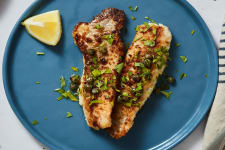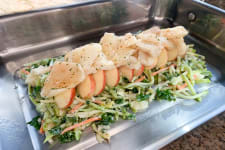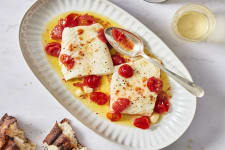Cooking fish perfectly every time is an easy skill to learn when you understand how to use internal temperatures for fish. This guide is tailored toward perfecting cook times for wild-caught Alaskan fish, since wild species can cook differently than farmed fish.
This ultimate guide will provide you with essential tips to ensure you hit the right fish temp every time for delicious results.
What Temperature Should Fish Be Cooked to?
Knowing the internal temperature of your fish is the best indicator about how raw, tender, or flaky a fillet will turn out.
When fish is cooked to too low an internal temperature, it can have a chewy texture. Uncooked fish is naturally chewy and will not flake easily. It can even be tough to cut with a knife. On the other hand, if fish is cooked until well-done, it can become tough and dry. High internal cook temperatures may help reduce the risk of food-borne illnesses, but you may not enjoy eating the fish. Different types of fish become flaky and moist at different internal temperatures, depending on its unique qualities.
Use an instant-read thermometer for the most accurate reading. An instant-read thermometer is easy to use — remember that the surface temperature of a fillet will be higher than the center of a fillet, since it’s exposed more directly to heat. When using the thermometer, place the probe in the center of the thickest part of your fillet, and you will know your fish internal temp.
Ideal Temperatures for Different Fish
Wild Salmon: Aim of a maximum of 120 degrees F to keep it tender.
White Fish (like Pacific cod or Pacific Halibut): Target around 130 degrees F.
Very Fatty Fish (like Sablefish): Can go up to 135 degrees F.
These suggested fish cooking temps will leave you with tender fillets that are cooked to medium-rare or medium doneness, depending on the type of fish.
-
Medium-rare fish will be opaque on the outside and a little translucent on the inside. This is around the point when wild salmon gets flaky, but still has enough moisture to be tender. Cooking it past this point to a medium doneness can give it a drier feel, but it should still be easy to flake.
-
Medium-done fish will be opaque on the outside and just opaque on the inside. For most white fish, this is when the fillet reaches peak flakiness. Medium-rare white fish will be moist but tends to resist flaking.
-
When cooking very fatty species of white fish, such as sablefish, you can be less precise with the internal temperature since the fat content helps to keep the fish moist as it cooks. Aim for medium doneness (130 degrees F) but don’t be afraid to cook it up to 135 degrees F if you need a few extra minutes to crisp up the skin or get a char on the fillet under the broiler.
You should adjust according to your own tastes and preferences, but these are tried-and-true temperatures that you can use as a guideline for your own cooking. If you prefer something a little less done, aim for a lower temperature. If you prefer something more cooked, aim for a higher temperature.

Food Safety and Internal Temperature
While the FDA suggests 145 degrees F for safety, this might result in dry fish. Adjust according to your preference, balancing safety and texture.
Remember, your fish continues to cook even off the heat, especially when using high-heat methods such as pan-frying, broiling, or grilling. Remove your fish from heat a few degrees before your target temperature to account for carryover cooking.
Mastering fish internal temps is vital to perfect cooking. With this guide, you’re well on your way to delicious, perfectly cooked fish every time.






